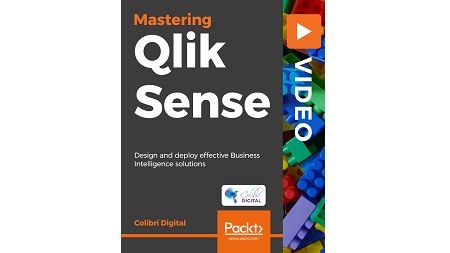
English | MP4 | AVC 1920×1080 | AAC 48KHz 2ch | 3h 43m | 1.25 GB
Debug common issues and optimize your data model to achieve the best performance for your Qlik Sense app
You’ve probably done some beginner work on Qlik Sense, so you know how easy it is to work with the interface. However, there is always more than what we see on the Qlik Sense dashboard. Work done by developers in the extremity plays a very important role while making an appealing and well-performing dashboard.
If your data model is not designed appropriately, you will face issues not only with the performance of the app but also with the quality of its output.
In this course, we look at everything that goes into creating a data model to give you the most optimized performance, including how to load data from different data sources, fix synthetic keys, and other issues. Also included are topics such as creating link tables, the master calendar script, and applying set analysis to your data. Thus, you will master the art of creating dashboards that are not only visually appealing and accurate but also very informative and a BIG bonus to your team while making those tough decisions.
Learn
- Dive into schemas in data modeling and Qlik Sense preferences when creating dashboards with accelerated performance
- Load data from different data sources and know about the various connectors available within Qlik Sense
- Fix real-world issues you face, such as synthetic keys while loading your data
- Modify data in existing tables to obtain values required for your dashboard design as per business requirements
- Transform data to generate new columns and achieve desired outcomes on the dashboard
- Understand the use and benefits of including Preceding Load and Mapping Load in your data model
- Take a look at the different types of join and use them to optimize data models
- Realize the significance of Link Tables and how to create them so you can get better insights
- Master the Calendar script and modifications that we can make to obtain fields for timeline analysis
Table of Contents
Qlik Sense – Going Beyond Essentials
1 Course Overview
2 What’s New in Qlik Sense
3 Understanding the Schemas
4 Our Objective – The Data Model
Applying Set Analysis and Section Access
5 Introduction To Set Analysis
6 How Does Set Analysis Work
7 Section Access
8 Section Access Script
9 Moving on From Here…
Loading data in Qlik Sense#
10 Introduction to Data Load Editor
11 Loading Data in Qlik Sense
12 What is Data Transformation
Synthetic Keys – Common Issues and Solutions
13 Loading Dimension Tables
14 Synthetic Keys – Problems Arising from Them
15 Synthetic Keys – Choosing a Solution That Works for You
16 Synthetic Keys – Impact on Your Dashboard
Debugging Common Issues around Circular References
17 Loading Data – Database Example
18 Loading Data from Other Data Files
19 What Impact Does Circular Reference Have
20 Resolving Circular References
21 Impact of the Circular References on the Dashboard
Doing More with Your data #
22 Using the Where Clause to Filter Data
23 Using Resident Load to Manipulate Data
24 Using Where Exists for comparisons
25 Adding Counters When Needed
Using Mapping Tables and Preceding Load
26 Mapping Load
27 Preceding Load
Optimizing Data Model with Joins
28 Introduction of Joins
29 Using Joins
30 Concatenation in Qlik Sense
31 Auto- Concatenation in Qlik Sense
32 Forced Concatenation in Qlik Sense
Class Function and Link Tables
33 Grouping Data Using Class Function
34 How To Use the Class Function
35 Link Tables in Qlik Sense
Making the Most of Master Calendar
36 Master Calendar
37 Master Calendar MinMaxDate
38 Master Calendar –Final Script
39 Master Calendar – Dashboard Example
Resolve the captcha to access the links!